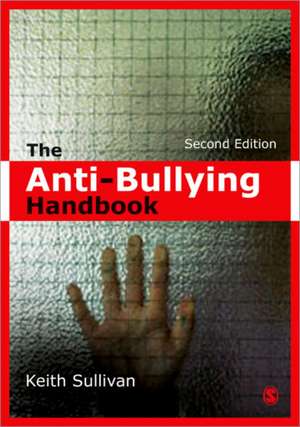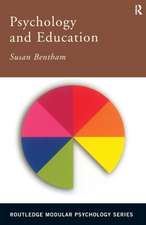The Anti-Bullying Handbook
Autor Keith Sullivanen Limba Engleză Paperback – 8 noi 2010
This book is a useful resource for all schools, from those just starting to consider setting up an anti-bullying initiative, to those with well-established programmes that wish to consider anti-bullying best practice.
New material in this edition includes:
- What we know and can do about cyberbullying
- Teaching the very young and children aged 5-12 about bullying
- Confronting issues through collaborative and restorative justice techniques
- Social Action Drama
This book is a key resource for teachers, administrators, counsellors, therapists, psychologists, teacher trainers, students and parents.
Keith Sullivan is a widely published author and professor of Education at the National University of Ireland, Galway.
Preț: 411.21 lei
Nou
Puncte Express: 617
Preț estimativ în valută:
78.68€ • 82.37$ • 65.11£
78.68€ • 82.37$ • 65.11£
Carte tipărită la comandă
Livrare economică 07-21 aprilie
Preluare comenzi: 021 569.72.76
Specificații
ISBN-13: 9781849204804
ISBN-10: 1849204802
Pagini: 280
Ilustrații: figures
Dimensiuni: 170 x 242 x 15 mm
Greutate: 0.49 kg
Ediția:Second Edition
Editura: SAGE Publications
Colecția Sage Publications Ltd
Locul publicării:London, United Kingdom
ISBN-10: 1849204802
Pagini: 280
Ilustrații: figures
Dimensiuni: 170 x 242 x 15 mm
Greutate: 0.49 kg
Ediția:Second Edition
Editura: SAGE Publications
Colecția Sage Publications Ltd
Locul publicării:London, United Kingdom
Recenzii
'This book is a welcome and refreshing addition to the titles on bullying. It will be very useful for a broad audience of people concerned about the important problem of school bullying; educators will find it particularly valuable. I greatly appreciate the humanistic, constructivist perspective taken by this author, and by extension, the focus on non-punitive approaches to deal with the problem. The socio-ecological view of the problem is consistent with current "systems" understanding of this behavior. This is a practical book, filled with suggestions of a variety of sound strategies for preventing and intervening in bullying situations. The preventative strategies go beyond the typical anti-bullying programs and describe pedagogical methods to create an environment that discourages bullying. The preventive strategies include the non-punitive methods that I think do not get sufficient attention. The format of the text is quite appealing; the layout is reader-friendly, and the figures are excellent. They present the text material in a visual way that helps readers understand the relationships among concepts. I heartily recommend this book to all who would like a fresh perspective and practical, usable ideas to apply in their own settings' -
Sheri Bauman, Ph.D.
Director
School Counseling Program
Editor, Journal for Specialists in Group Work
Sheri Bauman, Ph.D.
Director
School Counseling Program
Editor, Journal for Specialists in Group Work
Cuprins
PART ONE: DEFINING AND DESCRIBING BULLYING
Introduction
What We Know about Bullying
The Bullying Triangle and the Bullying Dynamic
Types of Bullying 1: Racist Bullying, Bullying of Special Educational Needs Children, Homophobic Bullying and Sexual Bullying
Types of Bullying 2: Cyberbullying
PART TWO: PHILOSOPHY, PLANNING AND POLICY
How to Create an Anti-Bullying Initiative
Developing a Philosophy About Bullying
Planning and Information Gathering
Creating a School Anti-Bullying Policy
PART THREE: PREVENTATIVE STRATEGIES
Strategies for Teachers: Practice, Pedagogy and Learning
Strategies for Teachers: Understanding Social Relationships, Creating Safe Classrooms
Interactive and Experiential Strategies
Harnessing the Power of the Peer Group
The School Environment
PART FOUR: INTERVENTIONS
Peer Mentoring and Peer Mediation
The Support Group Method
A Circle of Friends
The Pikas Method of Shared Concern
CPR: Collaborative Problem-solving and Resolution
PART FIVE: FOLLOW-UP AND CONCLUSION
Follow-up and Conclusion
APPENDICES
Appendix 1 A School Anti-Bullying Policy
Appendix 2 Using Bullying Scenarios
Appendix 3 Ethics and Confidentiality
Appendix 4 Ice Breakers
Introduction
What We Know about Bullying
The Bullying Triangle and the Bullying Dynamic
Types of Bullying 1: Racist Bullying, Bullying of Special Educational Needs Children, Homophobic Bullying and Sexual Bullying
Types of Bullying 2: Cyberbullying
PART TWO: PHILOSOPHY, PLANNING AND POLICY
How to Create an Anti-Bullying Initiative
Developing a Philosophy About Bullying
Planning and Information Gathering
Creating a School Anti-Bullying Policy
PART THREE: PREVENTATIVE STRATEGIES
Strategies for Teachers: Practice, Pedagogy and Learning
Strategies for Teachers: Understanding Social Relationships, Creating Safe Classrooms
Interactive and Experiential Strategies
Harnessing the Power of the Peer Group
The School Environment
PART FOUR: INTERVENTIONS
Peer Mentoring and Peer Mediation
The Support Group Method
A Circle of Friends
The Pikas Method of Shared Concern
CPR: Collaborative Problem-solving and Resolution
PART FIVE: FOLLOW-UP AND CONCLUSION
Follow-up and Conclusion
APPENDICES
Appendix 1 A School Anti-Bullying Policy
Appendix 2 Using Bullying Scenarios
Appendix 3 Ethics and Confidentiality
Appendix 4 Ice Breakers
Notă biografică
Keith Sullivan is a widely published author. He is professor of Education at the National University of Ireland, Galway.
Descriere
Comprehensive user-friendly overview of all aspects of bullying in schools, and the recognised techniques to counter this











